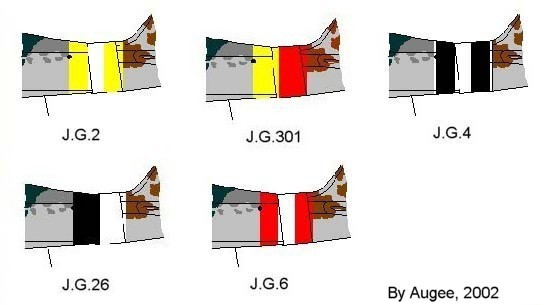Focke-Wulf 190 / Ta 152 Camouflage and Markings
Here are a couple of primary documents dealing with markings worn by FW 190s and Ta 152s during World War II. I've included brief summaries with each one. Thanks to Dave Wadman and Nick Beale, who allowed me to reproduce this information here, and thanks to Augee for the RV bands diagram.
RV Bands
From a translated Luftwaffe document dated 20 February 1945:
"Subject: Jagdgeschwader markings
By order of the Reichsmarschall and for the purpose of improving aerial recognition, Jagdgeschwader aircraft are to be marked by fuselage-encircling coloured stripes as indicated in the appended enclosure [see below]. Attention of troops down to platoon level is to be drawn to these markings which should simplify the recognition and distinction of our own aircraft.
IA
[signature illegible]
Leutnant u. Ord - Offz."
A second page had diagrams of the colours. Widths for bands were: one colour band - 900 mm, two colour band - 450 mm each, three colour band - 300 mm each. The colours for each Jagdgeschwader were listed as below:
J.G. 1 - Bright Red
J.G. 3 - White
J.G. 11 - Yellow
J.G. 27 - Bright Green
J.G. 53 - Black
J.G. 54 - Bright Blue
J.G. 5 - Black / Yellow
J.G. 7 - Blue / Red
J.G. 26 - Black / White
J.G. 52 - Red / White
J.G. 77 - White / Green
J.G. 301 - Yellow / Red
J.G. 2 - Yellow / White / Yellow
J.G. 4 - Black / White / Black
J.G. 6 - Bright Red / White / Bright Red
J.G. 51 - Bright Green / White / Bright Green
J.G. 300 - Bright Blue / White / Bright Blue
Focke-Wulf 190 D-9 RV Bands

Yellow Chevron Marking
From ULTRA decrypt HP 1207 of September 1944:
"Early 22nd [September 1944] Luftflotte 4 appreciated that on Rumanian front 'the enemy' was operating German aircraft in some cases with German markings. In order to identify German aircraft with certainty additional recognition markings in yellow paint ordered for Bf 109, FW 190, Ju 87, Ju 88, Ju 188, Hs 129, He 111 and Do 217. 40 cm ring around fuselage in front of wings. Lower side of port wing, whole width of wing a Victor [yellow chevron] open towards direction of flight with an angle of 45 degrees and arms 25 cm broad. The arms of the Victor to be carried over leading edge of wing to upper side for distance of 60 cm to permit recognition from above also. Completion to be reported by early 25th, from then on all above aircraft not carrying new markings could be fired on at 30 km distance from front."
Nick Beale also quoted from G. Punka, Messer - The Messerschmitt 109 in the Royal Hungarian Honvéd Air Force, OMIKK, Budapest, 1995, p.119. This quote describes the replacement of the yellow chevron marking with the 1945 yellow nose band and yellow rudder combination:
"From March 7th 1945 on, following the 4th Fliegerkorps' directives, day fighters in the south-east sector of the front displayed new Theatre of Operations markings: a 50 cm wide yellow band was painted around the front of the engine, right behind the spinner and the rudder was painted yellow. The previous yellow "V" and fuselage band were omitted."

Example of the 50 cm wide yellow marking around the engine (D. Wadman)
If those were of interest, let me know and I'll post up some more.
Home


